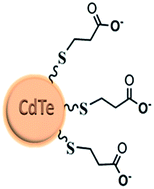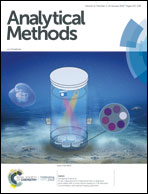Fluorescence-quenching CdTe quantum dots applied for identification of cocaine-structure analogues
Abstract
Cocaine is an illicit drug that is being increasingly used worldwide. Therefore, the development of new methods to detect cocaine and to distinguish it from false positives is necessary. For the first time, we have investigated how cadmium telluride quantum dots (CdTe QDs) interact with cocaine, lidocaine or procaine, as hydrochloride salts, by fluorescence spectroscopy and by using the Stern–Volmer model at different temperatures (298, 304 and 311 K). The Stern–Volmer fluorescence quenching constant (KSV), binding constant (KB), number of binding sites (n) and the thermodynamic parameters (ΔGθ, ΔHθ and ΔSθ) were obtained for each compound through the fluorescence quenching data. The results showed differences that signalled distinct quenching mechanisms and demonstrated that the structure of the hydrochlorides influenced the way they interacted with CdTe QDs, which could lead to a promising method to distinguish between cocaine and its two potential false positives, procaine and lidocaine, in colorimetric forensic tests.



 Please wait while we load your content...
Please wait while we load your content...